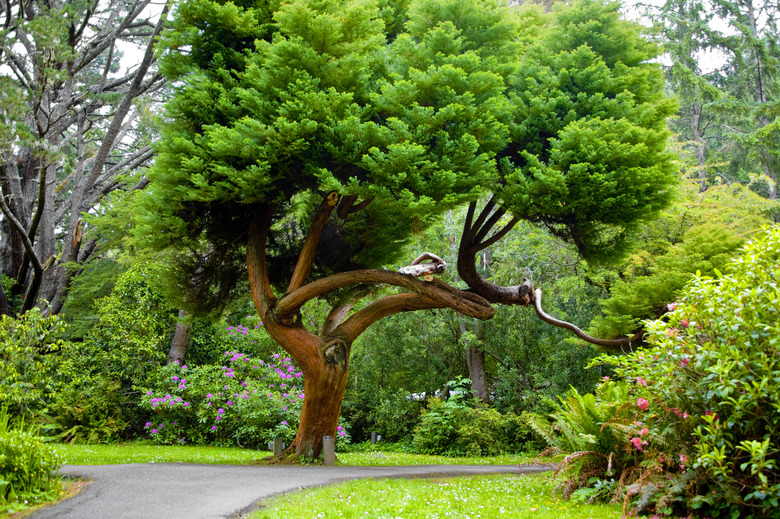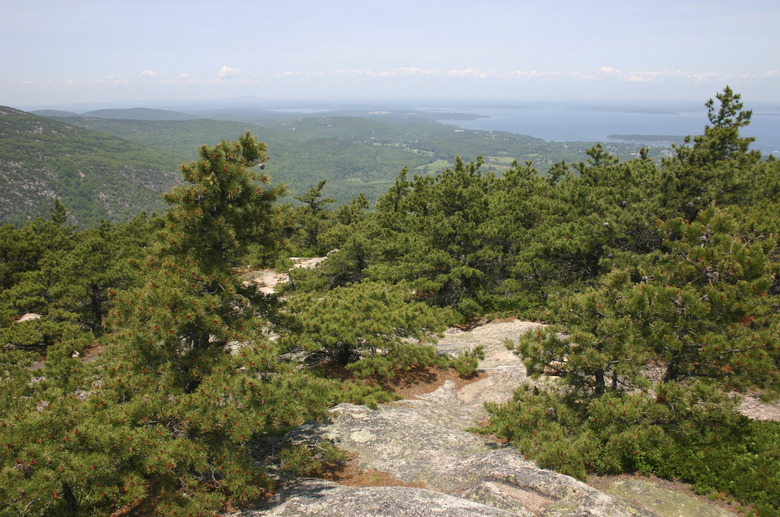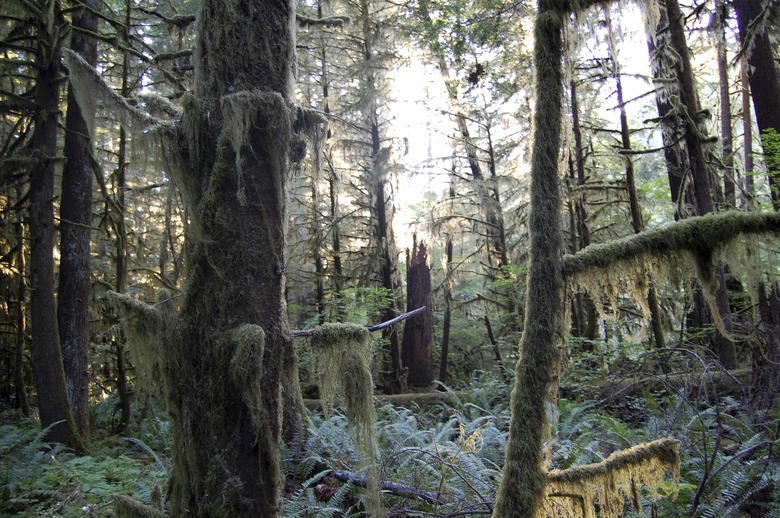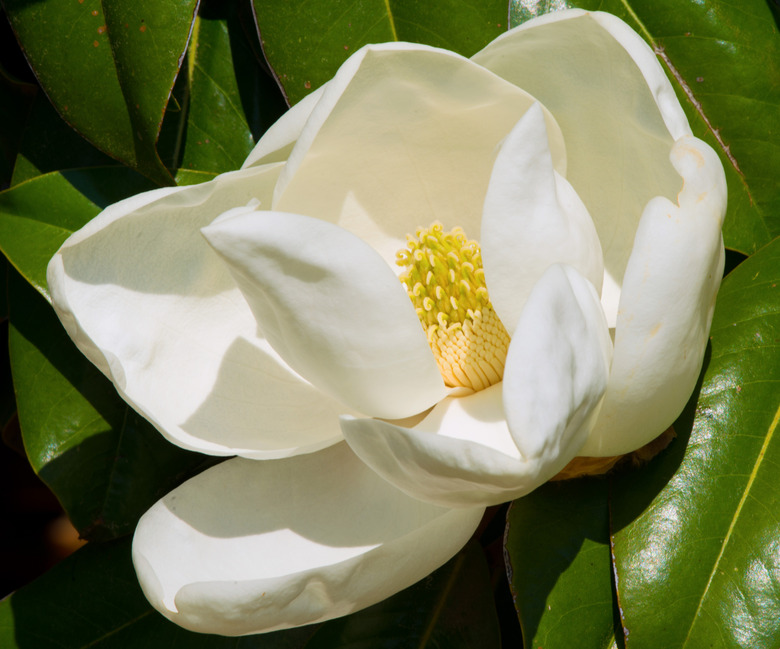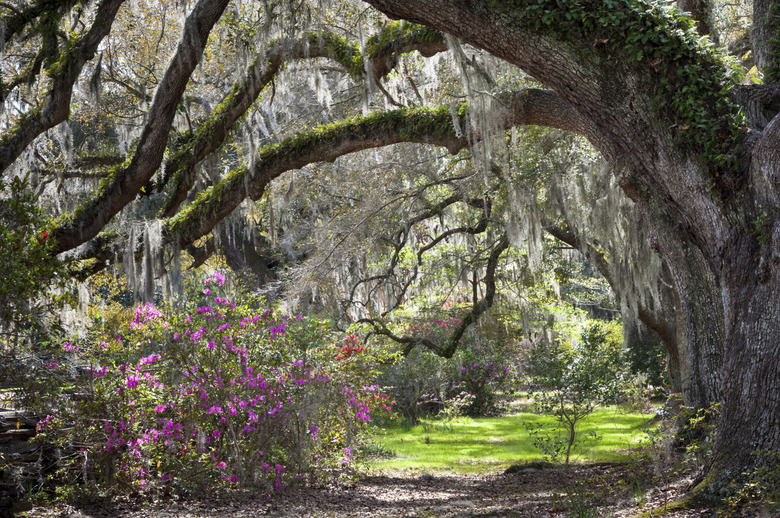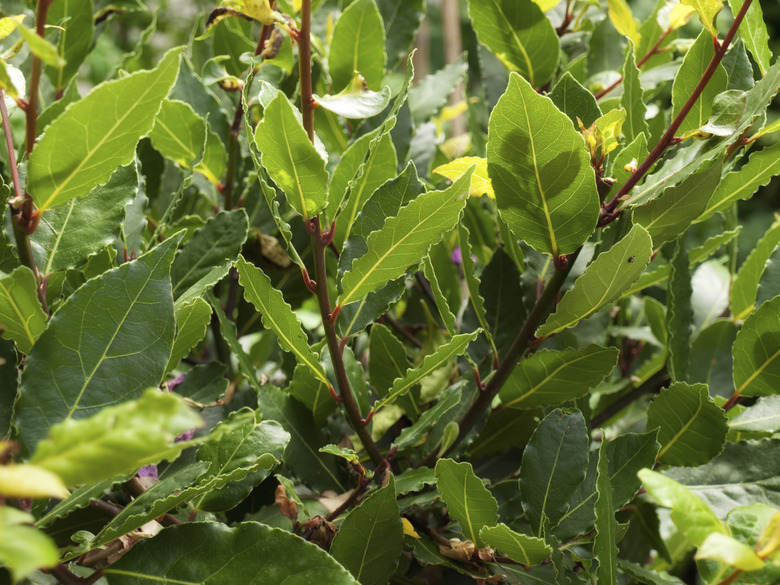List Of Evergreen Trees
Evergreen trees keep their foliage year round. Deciduous trees' leaves change color in autumn and then fall off, leaving bare branches until spring. Photosynthesis, the process in which plants use sunlight to convert carbon dioxide and water to oxygen and sugars, occurs in leaves. In evergreens, this process continues all year. Each evergreen variety is either narrow- or broad-leaved. The narrow leaves are often called needles.
Red Cedar
The **narrow-leaved red cedar** (Juniperus virginiana), which is hardy in U.S. Department of Agriculture plant hardiness zones 2 through 9, usually grows 30 to 65 feet in height with an 8- to 25-foot foliage width or spread. Also called eastern red cedar, the tree is often used as a privacy screen. This non-flowering, low-maintenance evergreen thrives in a site with full-sun exposure and dry to medium moisture. It tolerates dry and shallow, rocky soil. Its foliage may turn brownish-green during winter. A red cedar is either male or female; a female produces 1/4-inch-diameter, berrylike cones in fall.
Warning
Red cedar is an invasive species in many U.S. locations, including Haleakala National Park on the island of Maui, Hawaii. The top of Haleakala is at roughly 10,000 feet, which provides the cool temperatures that are ideal for red cedar, which isn't native to Hawaii.
Jack Pine
The jack pine (Pinus banksiana, USDA zones 2 through 6) is a narrow-leaved evergreen that grows throughout North America. It reaches 35 to 50 feet in height with a spread of 20 to 30 feet. Its roughly 1 1/2-inch-long needles are olive green but sometimes have a yellowish tone during winter. Its cones are slightly curved and up to 2 1/2 inches long. Jack pine is often used as a windbreak and occasionally as an accent tree in large yards with natural-style landscapes. Its branches tend to grow in different directions. In low sunlight conditions, its low branches tend to turn brown but stay on the tree, adding to its rumpled appearance. Other than trimming it to preference, the jack pine is low-maintenance, growing best with full sun, a cool climate and moderate amount of water.
Douglas Fir
Having a native range from southwestern British Columbia to west-central California, the narrow-leaved douglas fir (Pseudotsuga menziesii, USDA zones 4 through 6) thrives in cool temperatures, full sun and medium to wet soil. It is used for timber but rarely as a landscape species because of its size. It has a 40- to 80-foot height and 12- to 20-foot spread. The tree's 1 1/2-inch-long needles, which emit a distinctive scent when bruised, are dark green with white banding on their undersides. The cones reach 4 to 5 inches long and have trident-shaped bracts. As the tree matures, its bottom branches fall off until eventually foliage is on only the tree's upper one-third.
Warning
Douglas fir is considered an invasive species in several U.S. states and in Haleakala National Park.
Southern Magnolia
The broad-leaved southern magnolia (Magnolia grandiflora, USDA zones 7 through 9; sometimes 6b protected areas but may shed leaves in winter) is native to the southeastern United States. It grows 60 to 80 feet tall with a 30- to 50-foot spread. It prefers full sun or partial shade and moist, organically rich, well-drained, loamy soil. The **show-stoppers are its flowers,** fragrant white blooms that are usually 8 to 12 inches wide. Flowering occurs from May to June, with the resulting conelike fruits maturing from late summer to fall. Its leaves are leathery, a shiny dark green and can grow 10 inches long. Southern magnolia is usually grown as a specimen tree in yards and public gardens.
Live Oak
The broad-leaved live oak (Quercus virginiana, USDA zones 8 through 10) is a native of the southeastern United States and Mexico. Standing 40 to 80 feet tall with a spread up to 100 feet, live oak is often used as a shade tree in large residential yards and in parks. The low-maintenance tree prefers full sun and can grow in a variety of soil types as long as they drain well. Oversaturated soil may lead to root rot. Tiny, yellowish-green flowers appear on the tree in March and April, producing acorns up to 1 inch long. Its leaves are leathery, dark green, shiny and grow up to 5 inches long.
Bay Laurel
The bay laurel (Laurus nobilis, USDA zones 8 through 10) is a Mediterranean import known for its fragrant leaves that are used to flavor pastas and other dishes. In areas cooler than its hardiness range, this broad-leaved variety can be grown in a container and overwinter indoors in a cool space with lots of light. In the ground outdoors, it grows best in full sun or partial shade and moist, well-drained soil; it needs a moderate amount of water. A bay laurel planted in the ground outdoors averages 10 to 30 feet in height and a 5- to 20-foot spread. Sometimes it is labeled as a large shrub and often found on patios, in herb gardens and used as a privacy screen. Its leaves are 2 to 4 inches long, dark green and shiny. From March to May, tiny, yellowish-green flowers appear on a female bay laurel. The resulting fruits are tiny, single-seeded, purple-black berries.
References
- Missouri Botanical Garden: Juniperus Virginiana
- Invasive Plant Atlas of the United States: Eastern Red Cedar
- Missouri Botanical Gardens: Pinus Banksiana
- Missouri Botanical Gardens: Pseudotsuga Menziesii
- Invasive Plant Atlas of the United States: Douglas Fir
- Missouri Botanical Garden: Magnolia Grandiflora
- Missouri Botanical Garden: Quercus Virginiana
- Missouri Botanical Gardens: Laurus Nobilis
